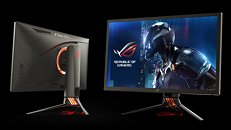Raevenlord
News Editor
- Joined
- Aug 12, 2016
- Messages
- 3,755 (1.20/day)
- Location
- Portugal
| System Name | The Ryzening |
|---|---|
| Processor | AMD Ryzen 9 5900X |
| Motherboard | MSI X570 MAG TOMAHAWK |
| Cooling | Lian Li Galahad 360mm AIO |
| Memory | 32 GB G.Skill Trident Z F4-3733 (4x 8 GB) |
| Video Card(s) | Gigabyte RTX 3070 Ti |
| Storage | Boot: Transcend MTE220S 2TB, Kintson A2000 1TB, Seagate Firewolf Pro 14 TB |
| Display(s) | Acer Nitro VG270UP (1440p 144 Hz IPS) |
| Case | Lian Li O11DX Dynamic White |
| Audio Device(s) | iFi Audio Zen DAC |
| Power Supply | Seasonic Focus+ 750 W |
| Mouse | Cooler Master Masterkeys Lite L |
| Keyboard | Cooler Master Masterkeys Lite L |
| Software | Windows 10 x64 |
It's confirmed: no 144 Hz 4K gaming with HDR in 2017 for NVIDIA gamers who want to make use of G-Sync t avoid screen tearing in their games. Acer last week announced that its 4K HDR Predator X27 gaming display would be delayed to Q1 2018 (meaning, no such thing below your Christmas tree or on your fireplace sock, sadly.) But it isn't Acer's fault, apparently: ASUS's ROG Swift PG27UQ, which features virtually the same specifications, has also been delayed to 2018. Both these monitors are based of an NVIDIA reference design showcased at Computex 2017 (you may remember a slight foul play there as well.)
The Acer Predator X27 and the ASUS ROG Swift PG27UQ are based on AU Optronics' M270QAN02.2 AHVA panel, which offers a 3840×2160 resolution and can reach a 144 Hz refresh rate. Something that really should make these monitors shine is the usage of a direct LED backlighting system with 384 zones, which can be individually dimmed or brightened as needed, which allows the panel to deliver much higher levels of contrast, needed for true HDR display. At least until OLED panels make their way to high-performance gaming monitors, these are expected to be the best of the crop.


So far, only Acer and ASUS have announced displays based on this panel and NVIDIA's reference design. Neither Acer nor ASUS have disclosed the reason for the delay, but a quick mental effort says that since two different brands are involved, the problem must be not with their expertise or technical inadequacy to solve the problem: it must be a common factor to both that is affecting their capability to deliver. So, this could have something to do with NVIDIA's reference design (that the brands need to rework/polish), or due to their sole supplier of this particular panel: AU Optronics. Should we see any FreeSync monitors using the same AUO panel crop up until then, we'll know the answer to that particular question.
View at TechPowerUp Main Site
The Acer Predator X27 and the ASUS ROG Swift PG27UQ are based on AU Optronics' M270QAN02.2 AHVA panel, which offers a 3840×2160 resolution and can reach a 144 Hz refresh rate. Something that really should make these monitors shine is the usage of a direct LED backlighting system with 384 zones, which can be individually dimmed or brightened as needed, which allows the panel to deliver much higher levels of contrast, needed for true HDR display. At least until OLED panels make their way to high-performance gaming monitors, these are expected to be the best of the crop.


So far, only Acer and ASUS have announced displays based on this panel and NVIDIA's reference design. Neither Acer nor ASUS have disclosed the reason for the delay, but a quick mental effort says that since two different brands are involved, the problem must be not with their expertise or technical inadequacy to solve the problem: it must be a common factor to both that is affecting their capability to deliver. So, this could have something to do with NVIDIA's reference design (that the brands need to rework/polish), or due to their sole supplier of this particular panel: AU Optronics. Should we see any FreeSync monitors using the same AUO panel crop up until then, we'll know the answer to that particular question.
View at TechPowerUp Main Site
Last edited:







 . The one I have is just barely light enough.
. The one I have is just barely light enough.